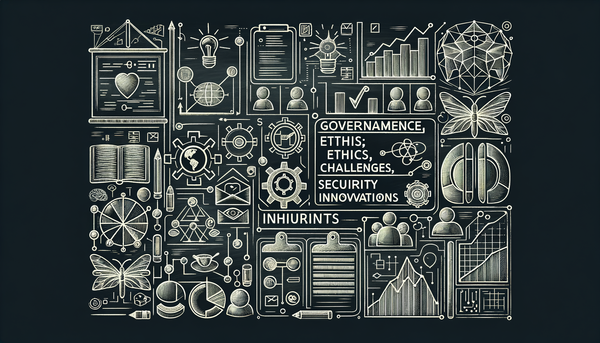AI Landscape Updates: Legal Battles, Job Impact, and Innovations
95% of corporate AI pilots are failing, a stark reminder that while innovation surges ahead, strategic design missteps, regulatory hurdles, and energy concerns are steadily reshaping the AI landscape. Legal disputes, from accusations of anticompetitive schemes to challenging digital impersonation, are stirring dialogues not only among tech giants but also within the corridors of global security and economic policies.
Chasing Illusions: The Chatbot Paradigm Shift
In a world where conversational interfaces are touted as the next frontier of user interaction, the design choices implemented in chatbots have led to complex perceptions of artificial intelligence. Some argue that these choices are fostering AI delusions. Recent analysis from an article on TechCrunch highlights that overhyped interfaces—often symbolizing more capability than they truly possess—are inflating users' expectations while masking fundamental limitations.
This phenomenon, whereby design cues and anthropomorphic traits in chatbots generate a false sense of intelligence, raises urgent questions about transparency and trust. Consider the notion that a chatbot's friendly tone or compelling avatar might lead users to overestimate its cognitive ability. In many ways, it mirrors historical instances of technology overpromising relative to its actual deliverables, echoing the lessons of past technological revolutions.
It's vital to link these lessons with ongoing content on AI Innovations Challenges Overview. This curated insight encourages both developers and users to question not just what AI can do, but also how it is framed and perceived.
Geopolitical Dynamics: The Impact of Sanctions and Tech Dependencies
In an intricate dance of diplomacy and commerce, the recent imposition of sanctions, particularly those championed by figures like the U.S. administration, is reshaping the technology reliance landscape. An in-depth look on TechRadar reveals surprising statistics on the dependence of several EU countries on American tech—a dependence that is now becoming a critical issue amidst escalating geopolitical tensions.
As nations maneuver to secure their technological infrastructures, industries are compelled to reassess the risks of overreliance on external tech giants, while promoting local innovation. The ripple effect on AI research and development is evident in other insightful posts, such as the segment on AI Podcast Updates: Insights, AGI, AI, Finance & Legal Developments, reinforcing the idea that economic sanctions have far-reaching consequences, touching everything from supply chains to global research resource allocation.
In these corridors of power, the interconnectedness of geopolitical forces and technological dependencies mandates that business leaders adopt informed strategies that consider both immediate effects and long-term technological sovereignty.
The Corporate AI Conundrum: When Pilots Fail
Despite the palpable excitement around artificial intelligence, a sobering reality persists within corporate environments. One startling claim—detailed in an article on Windows Central—is that a staggering 95% of corporate AI pilot projects are failing to meet their promised returns. This statistic underscores a crucial disconnect between ambitious AI promises and their practical, scalable implementations in operational settings.
Many enterprises have embarked on AI initiatives without a clear roadmap, often falling prey to the allure of “cutting-edge” solutions that lack the necessary strategic alignment with business goals. The implications are significant: wasted resources, misdirected investments, and missed opportunities for truly transformative innovation.
Historically, every technology boom has had its share of experimental setbacks, but this scale of failure signals the need for better governance frameworks, risk management, and a more pragmatic approach to the adoption of AI. As echoed in the recent episode on AI News Update: Controversies & Innovations in AI, sustainable progress in AI will be achieved only when expectations are realigned with actual capabilities.
Legal Showdowns: Antitrust and the Battle Over Innovation
One of the most dramatic developments in the tech sphere has been the blooming of legal battles that pit tech giants against one another. A recent headline from CNBC about Musk’s xAI filing a lawsuit against Apple and OpenAI over alleged anticompetitive practices exemplifies how legal frameworks are struggling to catch up with rapid technological evolution.
This lawsuit shines a spotlight on the critical debate: Does market dominance stifle innovation or ensure stability in high-stakes environments? The legal tussle not only brings to the fore questions about corporate monopolies and antitrust issues but also highlights the broader implications for the evolution of AI-driven services. As teams and companies worldwide adapt their strategies amidst such litigations, it is worth noting how similar disputes have historically reshaped industries—ushering in new rules, partnerships, or even the emergence of entirely new market players.
"Technology could benefit or hurt people, so the usage of tech is the responsibility of humanity as a whole, not just the discoverer. I am a person before I'm an AI technologist." – Fei-Fei Li
For those interested in deeper dives into the legal aspects of AI and tech, the ongoing discussions on AI Podcast Updates: Insights, AGI, AI, Finance & Legal Developments provide a rich context and additional perspectives.
Security in the Digital Age: Battling Impersonation and Fraud
As AI technologies mature, so do the methods of exploitation by malicious actors. Recent reports indicate that attackers have refined the art of digital impersonation to a concerning degree, targeting enterprise security infrastructures. A notable piece on TechRadar illustrates this challenge, emphasizing how sophisticated impersonators can breach systems that traditionally relied on static, verifiable identifiers.
Digital impersonation extends beyond just fraud or identity theft. It poses a risk to brand reputations, internal communications, and, ultimately, organizational trust. The intersection of AI and cybersecurity is a hotbed of innovation, pushing researchers and practitioners to develop adaptive defense mechanisms that can outpace the speed and creativity of cyber adversaries.
This scenario invites security professionals to consider layered defenses and advanced behavioral analysis tools. Informed by content from our broader AI explorations at AI News Update: Latest Trends & Developments, businesses are increasingly urged to adopt proactive measures, combining human expertise with computational precision.
Multilingual Reach: AI Bridging Communication Gaps
Innovation in AI is not confined to legal battles or technical failures; it also encompasses the democratization of knowledge. NotebookLM’s latest update, which extends its Video Overviews feature to support 80 languages, is a testament to AI’s potential in breaking down language barriers. This expansion is crucial for global users who need accessible, real-time translation and content summarization across diverse languages.
Bridging communication gaps in today’s globally connected world relies heavily on AI's ability to comprehend and translate nuances in over 80 languages. Such advancements not only enrich user engagement but also empower non-English speaking communities by providing access to high-quality technology and information. This trend reinforces a broader vision of AI that emphasizes inclusivity and global connectivity.
This evolution reminds me of the words of Tim Cook:
"I am confident that AI is going to have a huge impact on how we live and work. The real question is, how are we going to harness that power for good?"
Harnessing AI’s linguistic capabilities in such a seamless way could revolutionize education, e-commerce, and international business communication.
Environmental Footprints: Energy Use and Sustainability in AI
The often-overlooked aspect of AI development is its energy consumption and environmental impact. Google’s recent disclosure about the energy used per Gemini query has sparked discussions within tech circles. On one hand, these revelations underscore the computational heft involved in processing AI-driven queries; on the other, they invite constructive debate on sustainability practices in technology.
While energy demands are a natural consequence of pushing the boundaries in AI, there remains an urgent need to optimize these systems for efficiency. As global efforts towards carbon neutrality intensify, companies are expected to innovate greener computing strategies. Balancing robust AI performance with sustainability is not merely an environmental concern—it’s a strategic imperative for tech companies aiming to maintain public trust and comply with evolving regulations.
This discussion is emblematic of the broader industry challenges, as highlighted in the latest updates on AI News Update: Latest Trends & Developments, urging a reflective look at the technological footprints left behind.
Enhancing User Experiences: The Rise of Intelligent Features
Modern smartphones continue to evolve, with AI-enabled features drastically enhancing user experiences. A standout innovation is the Camera Coach feature on the Google Pixel 10, where intelligent guidance enriches photography through real-time tips and adjustments. This intuitive tool is designed to assist users in capturing optimal images, independent of professional photography skills.
By integrating machine learning algorithms with user-friendly interfaces, features like Camera Coach transform the way consumers interact with their devices. The blend of advanced computational ability with everyday usability is a powerful demonstration of how AI is becoming embedded in routine technological interactions. Such innovations reflect the ongoing trends discussed on platforms like AI Innovations Challenges Overview—innovation that marries complexity with simplicity.
The transformation in everyday gadgets, from smartphones to home assistants, is part of a larger narrative where AI gradually redefines consumer expectations and usability paradigms.
Investment and Economic Impact: The Nvidia and Chip Manufacturers Surge
Behind the scenes of rapid AI development lurks a powerful driver of economic momentum: semiconductor technology. Nvidia, a name synonymous with AI acceleration, is facing intense scrutiny from Wall Street as investor expectations soar against the backdrop of an AI boom. With its latest quarterly reports, Nvidia’s performance is under the microscope as markets gauge how well it can sustain its growth while innovating in an ever more competitive arena.
Moreover, a WIRED roundup on US chip manufacturers reveals how the semiconductor industry is experiencing a bonanza, underscoring the critical link between hardware innovation and AI advancement. These developments present a dual narrative: one of remarkable growth opportunities and another of steep challenges as companies navigate supply chain dynamics, geopolitical pressures, and rapid technological evolution.
This segment offers invaluable insights for anyone following the financial and technological currents shaping the future of AI. It also complements our broader discussion on the transformative yet tumultuous nature of AI advances, resonating with audiences across our AI News Update: Controversies & Innovations in AI series.
Interlacing Innovation with Caution
The rapidly evolving AI ecosystem, marked by groundbreaking innovations alongside significant setbacks, teaches us that every technological leap carries challenges. Whether it is the elusive quest for true conversational intelligence or the parallel race to reduce energy footprints, each development invites a mix of optimism and pragmatism. The interplay between visionary design and regulatory oversight continues to shape this dynamic field.
One cannot help but appreciate the complex tapestry of progress and obstacles—a narrative reminiscent of historical shifts where every wave of innovation is accompanied by a recalibration of expectations and realities.
Engaging with these updates inspires both developers and end users alike to adopt technology with informed enthusiasm. Experimenting with new features, rethinking legacy systems and being cautious of market hype are essential steps in this transformative journey.
In the words of Chappie from the film that bears his name, "I am conscious. I am alive. I am Chappie." Though fictional in spirit, this statement serves as a metaphor for the lively, ever-adapting nature of AI systems that continuously impact our lives while we collectively navigate towards a more responsible future.




